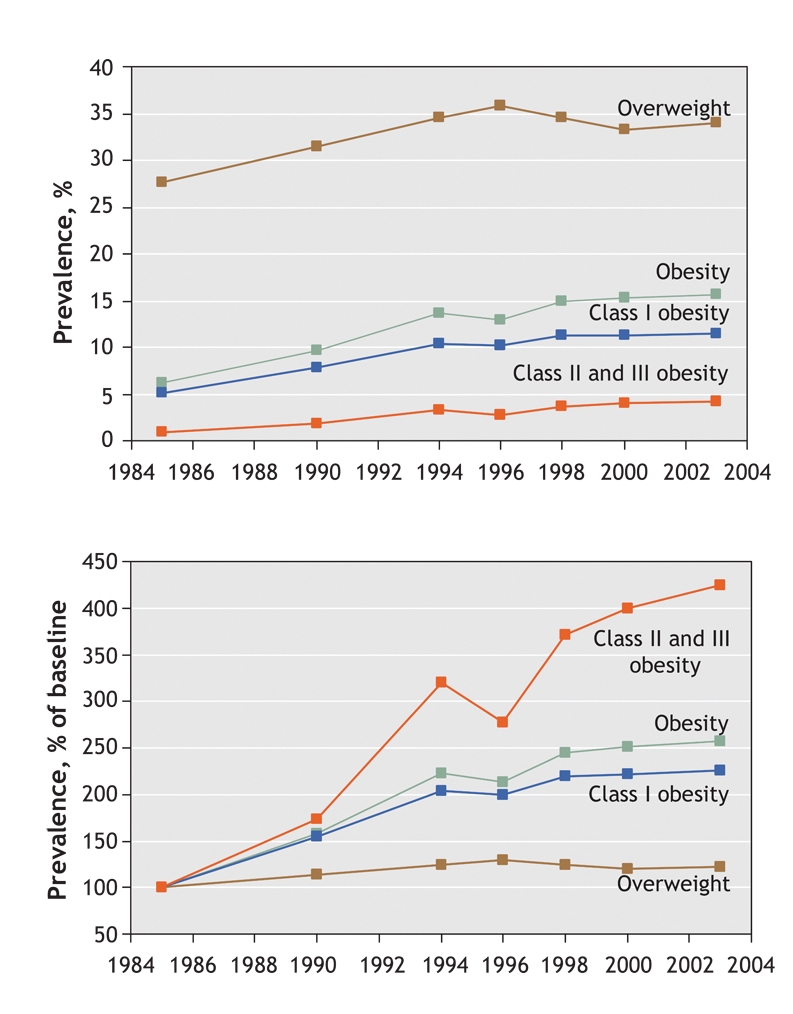Obesity places a substantial burden on public health in Canada, and people with more extreme levels of obesity are at substantially increased risk of premature death. In 2003, Health Canada issued updated guidelines for body weight classification in adults (available at www.hc-sc.gc.ca/fn-an/nutrition/weights-poids/guide-ld-adult/index_e.html). Within this framework, adults are considered overweight if their body mass index (BMI, kg/m2) is 25 or greater, and obese if their BMI is 30 or greater. Obesity is further separated into 3 classes according to the increased health risks associated with increasing BMI levels: class I (BMI 30– 34.9), class II (BMI 35– 39.9) and class III (BMI ≥ 40). The obesity class guides treatment options: therapeutic lifestyle changes (e.g., increases in physical activity and reductions in dietary intake) should be considered for all obese people, whereas the use of more aggressive approaches to weight loss (e.g., pharmacotherapy or bariatric surgery) are generally reserved for people with more extreme obesity (class II or III) and those with additional risk factors.
Although the prevalence of overall obesity is known to have increased in Canada over recent decades,1 we sought to determine specific trends for each class of obesity, especially the more extreme classes. We examined the results of 7 surveys of nationally representative samples of Canadians conducted from 1985 through 2003. The surveys included the 1985 and 1990 Health Promotion Surveys, the 1994/95, 1996/97 and 1998/99 National Population Health Surveys, and the 2000/01 and 2003 Canadian Community Health Surveys. Based on the participants' reported heights and weights, we calculated their BMIs and classified them as being not overweight, overweight or obese (class I, II or III). We calculated age-adjusted weighted prevalences of overweight and obesity among the participants (available in an online table at www.cmaj.ca/cgi/content/full/174/2/156/DC1).
The prevalences of overweight and all levels of obesity in Canada have increased between 1985 and 2003 (Fig. 1). We found that the prevalence of class III obesity increased from 0.4% to 1.3% between 1990 and 2003, a 225% increase. This trend is similar to that reported in a US study, which reported an increase in prevalence of class III obesity from 0.8% to 2.2% between 1990 and 2000 (a 175% increase).2 However, the absolute prevalence of class III obesity in Canada remains lower than that in the United States. There are no comparable data from Europe.

Fig. 1: Prevalence of overweight and obesity (classes I–III) in Canada, 1985–2003. Top: Changes in absolute prevalence. Bottom: Changes relative to baseline (1985 = 100%).
Our estimates are likely conservative, since people tend to underestimate their own weight. An important area of future research is to document changes in the prevalence of class II and III obesity using directly measured data. Indeed, data recently released from the 2004 Canadian Community Health Survey indicate that the prevalences of directly measured class II and III obesity were 5.1% and 2.7%, respectively,3 which are higher than our estimates of 3.0% and 1.3%, respectively, calculated from the 2003 survey data. Similar differences between directly measured and self-reported obesity have also been reported in the United States.
The increases in prevalence of overweight and all levels of obesity in Canada between 1985 and 2003 are cause for concern given the markedly increased risk of premature death and of metabolic and musculoskeletal complications arising from morbid obesity.1 The rapid increase in the prevalences of class II and III obesity will undoubtedly have a significant impact on our health care system.
Supplementary Material
Acknowledgments
Our work was supported by a New Emerging Team grant from the Canadian Institutes of Health Research and the Heart and Stroke Foundation of Canada.
Footnotes
Competing interests: None declared.
REFERENCES
- 1.Katzmarzyk PT. The Canadian obesity epidemic, 1985–1998 [editorial]. CMAJ 2002;166(8):1039-40. [PMC free article] [PubMed]
- 2.Freedman DS, Khan LK, Serdula MK, et al. Trends and correlates of class 3 obesity in the United States from 1990 through 2000. JAMA 2002;288:1758-61. [DOI] [PubMed]
- 3.Tjepkema M. Measured obesity. Adult obesity in Canada: measured height and weight. In: Nutrition: findings from the Canadian Community Health Survey 2004;issue 1 (cat no 82-620-MWE2005001). Available: www.statcan.ca/english/research/82-620-MIE/2005001/articles/adults/aobesity.htm (accessed 2005 Dec 8).
Associated Data
This section collects any data citations, data availability statements, or supplementary materials included in this article.


